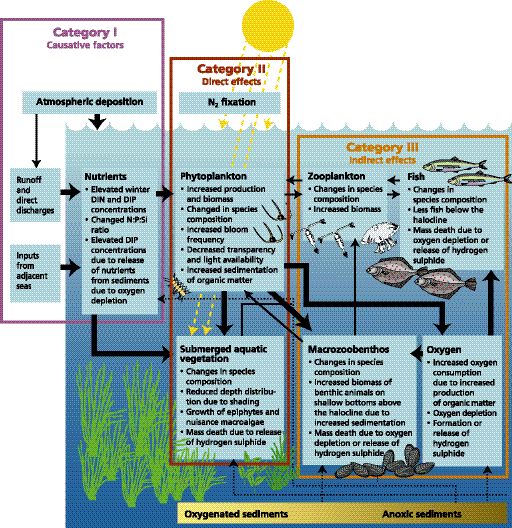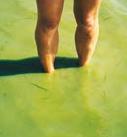Difference between revisions of "Eutrophication"
(→European Coastal Areas) |
(→The process of eutrophication) |
||
| Line 32: | Line 32: | ||
The different processes and effects of coastal eutrophication are well documented<ref>Cloern, J. (2001) Our evolving conceptual model of the coastal eutrophication problem. Mar. Ecol. Prog. Ser., 210, 223–253.[ISI]</ref> <ref>Conley, D. J., Markager, S., Andersen, J. et al. (2002) Coastal eutrophication and the Danish National Aquatic Monitoring and Assessment Program. Estuaries, 25, 706–719.[Medline]</ref> <ref>Rönnberg, C. and Bonsdorff, E. (2004) Baltic Sea eutrophication: area-specific ecological consequences. Hydrobiologia, 514, 227–241.[CrossRef][ISI]</ref>. and it has been considered as one of the biggest threats to marinne ecosystem health for decades<ref>Ryther and Dunstan, 1971</ref> <ref>Nixon, S. W. (1995) Coastal marine eutrophication: a definition, social causes, and future concerns. Ophelia, 41, 199–219.[ISI]</ref> <ref>Bachmann, R. W., Cloern, J. E., Heckey, R. E. et al. (eds) (2006) Eutrophication of freshwater and marine ecosystems. Limnol. Oceanogr., 51 (1, part 2), 351–800.</ref>. | The different processes and effects of coastal eutrophication are well documented<ref>Cloern, J. (2001) Our evolving conceptual model of the coastal eutrophication problem. Mar. Ecol. Prog. Ser., 210, 223–253.[ISI]</ref> <ref>Conley, D. J., Markager, S., Andersen, J. et al. (2002) Coastal eutrophication and the Danish National Aquatic Monitoring and Assessment Program. Estuaries, 25, 706–719.[Medline]</ref> <ref>Rönnberg, C. and Bonsdorff, E. (2004) Baltic Sea eutrophication: area-specific ecological consequences. Hydrobiologia, 514, 227–241.[CrossRef][ISI]</ref>. and it has been considered as one of the biggest threats to marinne ecosystem health for decades<ref>Ryther and Dunstan, 1971</ref> <ref>Nixon, S. W. (1995) Coastal marine eutrophication: a definition, social causes, and future concerns. Ophelia, 41, 199–219.[ISI]</ref> <ref>Bachmann, R. W., Cloern, J. E., Heckey, R. E. et al. (eds) (2006) Eutrophication of freshwater and marine ecosystems. Limnol. Oceanogr., 51 (1, part 2), 351–800.</ref>. | ||
| − | [[Image:eutrophicationflow.jpg|600px|centre|Source: | + | [[Image:eutrophicationflow.jpg|600px|centre|Source: HELCOM, 2006 <ref>HELCOM, (2006) Andersen, J (DHI) and Pawlak, J (MEC), Nutrients and Eutrophication in the Baltic Sea – Effects, Causes, Solutions. Baltic Sea Parliamentary Conference. </ref> |
]] | ]] | ||
| Line 45: | Line 45: | ||
| − | [[image:koncept.jpg|200px|frame|centre|Eutrophication schematic. Source: | + | [[image:koncept.jpg|200px|frame|centre|Eutrophication schematic. Source: HELCOM, 2006<ref>HELCOM, (2006) Andersen, J (DHI) and Pawlak, J (MEC), Nutrients and Eutrophication in the Baltic Sea – Effects, Causes, Solutions. Baltic Sea Parliamentary Conference. </ref>]] |
==European Coastal Areas== | ==European Coastal Areas== | ||
Revision as of 14:32, 19 January 2007
Eutrophication is an important process involving enrichment of water by excess nutrients. It can cause serious problems in the coastal zone through disturbance of ecological balances and fisheries, and through interference with recreational activities and quality of life.
Contents
What is eutrophication about?
- It’s about increased productivity (conversion of light and carbon dioxide into living organic matter – a process being limited by nitrogen and/or phosphorus) and unacceptable ecological effects as algal blooms, oxygen depletion, kills of benthic animals and fish
- It’s caused by increased inputs of nutrients from point sources, activities in the upstream catchment (e.g. losses from agriculture) and atmospheric deposition.
What are we really talking about?
- Eutrophication
- “eu” = “well” or “good”
- “trope” = “nourishment”
But is “eutrophication” good?
- In general: NO … it is actually ”bad” …
- Too many nutrients in wrong places may cause problems and result in changes in structure, function and stability of the marine ecosystems
- Eutrophication is ”too much of a good thing”
Some definitions:
- Eutrophication
- An increase in the supply of organic matter[1]
- A condition in an aquatic ecosystem where high nutrient concentrations stimulate growth of algae which leads to imbalanced functioning of the system[2].
- Alternative proposal
- The enrichment of water by nutrients, especially nitrogen and/or phosphorus and organic matter, causing an increased growth of algae and higher forms of plant life to produce an unacceptable deviation in structure, function and stability of organisms present in the water and to the quality of water concerned, compared to reference conditions[3]
The process of eutrophication
The different processes and effects of coastal eutrophication are well documented[4] [5] [6]. and it has been considered as one of the biggest threats to marinne ecosystem health for decades[7] [8] [9].
Effects of eutrophication on marine ecosystems are well known[11]:
- algal blooms resulting in green water
- reduced depth distribution of submerged aquatic vegetation
- increased growth of nuisance macroalgae
- increased sedimentation, increased oxygen consumption
- oxygen depletion in bottom water, and
- sometimes dead benthic animals and fish.

European Coastal Areas
The main source of nitrogen to European coastal waters is agricultural runoff discharged into the sea via rivers, identified as originating from sources of ammonia evaporation in animal husbandry and partly from fossil fuel combustion in traffic, industry and households[13]. For phosphorus the major sources are treated and untreated discharges to the sea from households and industry as well as soil erosion[14].
Baltic Sea in focus
Eutrophication seriously affects the Baltic sea marine environment, resulting in algal blooms, reduced water clarity, oxygen reduction and death of bottom animals. The causes behind this are well known[15]: discharges, losses and emissions of nitrogen and phosphorus to the aquatic environment. Reductions of discharges from municipal wastewater treatment plants and industries have been in focus for many years as have losses and emissions of nitrogen compounds from agriculture and traffic.
Solutions
Nutrient inputs must be reduced to levels that do not put at risk target values for mitigation of eutrophication. Integrated management strategies should enable characterization of all pressures on water bodies in order to develop a coherent approach to deal with the pressures in a cost effective manner[16]
EU Directives:
- EC Urban Waster Water Treatment Directive
- EC Nitrates Directive
- EU Water Framework Directive
- Marine Strategy Directive
See also
Wikipedia: Eutrophication article
External links
- Baltic Sea Parlimentary Conference
- BERNET: Baltic Eutrophication Regional Network
- BONUS for the future of the Baltic Sea
- European Environment Agency
- HELCOM
- HELCOM Indicator fact sheets: water exchange, winter nutrient concentrations, water clarity, algal blooms, chlorophyll-a concentrations, hydrography and oxygen in the deep basins
- MARE Research program on Baltic Sea environmental issues
- National Environment Research Institute (DK) Aquatic page
- Nutrients and Eutrophication in Danish Marine Waters
- OSPAR For the protection of the marine environment of the north-east Atlantic
- The Water Forecast
- WWF Baltic Ecoregion Programme
References
- ↑ Nixon, S. W. (1995) Coastal marine eutrophication: a definition, social causes, and future concerns. Ophelia, 41, 199–219.[ISI]
- ↑ HELCOM webpage, 2006 [1]
- ↑ Andersen, J. H., Schlüter, L. and Ærtebjerg, G. (2006) Coastal eutrophication: recent developments in definitions and implications for monitoring strategies. J. Plankton Res. 28(7): 621-628.
- ↑ Cloern, J. (2001) Our evolving conceptual model of the coastal eutrophication problem. Mar. Ecol. Prog. Ser., 210, 223–253.[ISI]
- ↑ Conley, D. J., Markager, S., Andersen, J. et al. (2002) Coastal eutrophication and the Danish National Aquatic Monitoring and Assessment Program. Estuaries, 25, 706–719.[Medline]
- ↑ Rönnberg, C. and Bonsdorff, E. (2004) Baltic Sea eutrophication: area-specific ecological consequences. Hydrobiologia, 514, 227–241.[CrossRef][ISI]
- ↑ Ryther and Dunstan, 1971
- ↑ Nixon, S. W. (1995) Coastal marine eutrophication: a definition, social causes, and future concerns. Ophelia, 41, 199–219.[ISI]
- ↑ Bachmann, R. W., Cloern, J. E., Heckey, R. E. et al. (eds) (2006) Eutrophication of freshwater and marine ecosystems. Limnol. Oceanogr., 51 (1, part 2), 351–800.
- ↑ HELCOM, (2006) Andersen, J (DHI) and Pawlak, J (MEC), Nutrients and Eutrophication in the Baltic Sea – Effects, Causes, Solutions. Baltic Sea Parliamentary Conference.
- ↑ DHI. (2006) Andersen, J (DHI) and Pawlak, J (MEC), Nutrients and Eutrophication in the Baltic Sea – Effects, Causes, Solutions. Baltic Sea Parliamentary Conference.
- ↑ HELCOM, (2006) Andersen, J (DHI) and Pawlak, J (MEC), Nutrients and Eutrophication in the Baltic Sea – Effects, Causes, Solutions. Baltic Sea Parliamentary Conference.
- ↑ Ærtebjerg, G. et al., Eutrophication in Europe’s Coastal Waters. Topic Report No 7/2001. European Environment Agency. [2]
- ↑ Ærtebjerg, G. et al., Eutrophication in Europe’s Coastal Waters. Topic Report No 7/2001. European Environment Agency. [3]
- ↑ DHI. (2006) Andersen, J (DHI) and Pawlak, J (MEC), Nutrients and Eutrophication in the Baltic Sea – Effects, Causes, Solutions. Baltic Sea Parliamentary Conference.)
- ↑ DHI. (2006) Andersen, J (DHI) and Pawlak, J (MEC), Nutrients and Eutrophication in the Baltic Sea – Effects, Causes, Solutions. Baltic Sea Parliamentary Conference.
Authorship 02/01/2007, Jesper Andersen (jha@dhigroup.dk), DHI Water Environment Health.
(Caitlin 09:31, 18 January 2007 (Romance Standard Time))


![Source: HELCOM, 2006 [10]](/w/images/thumb/3/35/Eutrophicationflow.jpg/600px-Eutrophicationflow.jpg)